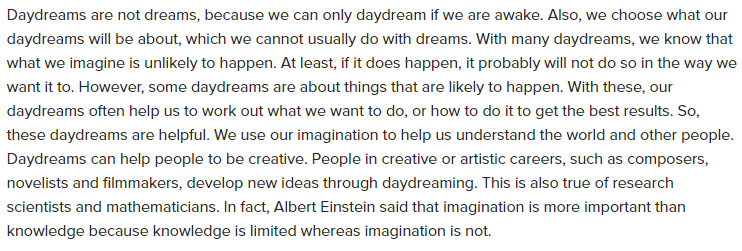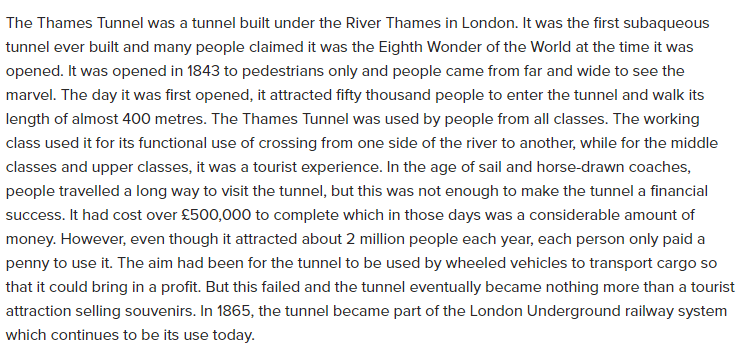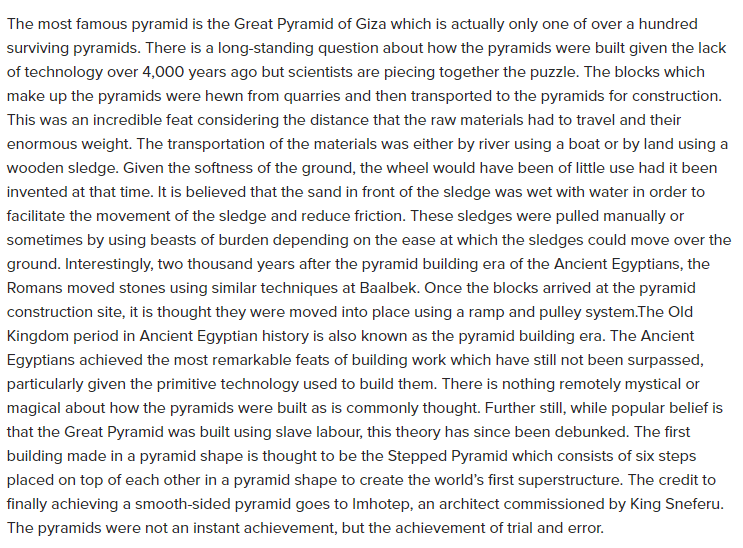Questions:
1. We can decide what to dream
2. Not all day dreams come true.
3. Day dreaming helps in formation of new ideas.
4. Day dreams may become dreams.
5. Issac Newton said that imagination is more important
than knowledge
Questions:
- The Thames Tunnel was the first
tunnel ever built under a river.
- The Thames Tunnel was the
Eighth Wonder of the World.
- The tunnel was used more by the
middle and upper classes.
- People were able to travel by
sea or land in those days.
- The aim of the tunnel was to turn
a profit as a tourist attraction.
Questions:
- The
controversy over the method used in the construction of the pyramids has
been solved by scientists.
- It is
possible that Ancient Egyptians could have lubricated paths to aid
transportation by sledge.
- Sledges
were dragged by animals not humans.
- The
Romans learned the techniques of moving huge stones from the Ancient
Egyptians.
- The
building work of the Ancient Egyptians is unrivalled.
Sample 4
The practice of
homeopathy was first developed by the German physician Samuel Hahnemann. During
research in the 1790s, Hahnemann began experimenting with quinine, an alkaloid
derived from cinchona bark that was well known at the time to have a positive
effect on fever. Hahnemann started dosing himself with quinine while in a state
of good health and reported in his journals that his extremities went cold, he
experienced palpitations, “infinite anxiety”, a trembling and weakening of the
limbs, reddening cheeks, and thirst. “In short,” he concluded, “all the
symptoms of relapsing fever presented themselves successively…” Hahnemann’s
main observation was that things which create problems for healthy people cure
those problems in sick people, and this became his first principle of
homeopathy: similia
similibus (with help from the same). While diverging from the principle
of apothecary practice at the time, which was contraria contrariis (with help from the opposite), the efficacy of similia
similibus was reaffirmed by subsequent developments in the field
of vaccinations. Hahnemann’s second principle was minimal dosing – treatments
should be taken in the most diluted format which remain effective. In case it
negated any possible toxic effects of similia similibus.
1.German Physician
Hippocrates first introduced the practice of homeopathy.
2. During the 1790s, Quinine, an alkaloid was widely used to
reduce fever as it had positive effects.
3. The first principle of homeopathy was the things that
cured problems in the sick people created problems in the healthy people.
4. The second principle of homeopathy by Hahnemann is
The Single Remedy theory, in which only one homeopathic remedy can be given at
any one time
5. Even in the pink of his health, Hahnemann started dosing
himself with Quinine.
Sample 5
The process starts when
you get the original script and a tape. ‘We would start by translating and
adapting the film script. The next step is what we call ‘timing’, which means
synchronizing the subtitles to the dialogue and pictures.’ This task requires discipline.
You play the film, listen to the voice and the subtitles are up on your screen
ready to be timed. You insert your subtitle when you hear the corresponding
dialogue and delete it when the dialogue finishes. The videotape carries a time
code that runs in hours, minutes, seconds, and frames. Think of it as a clock.
The subtitling unit has an insert key to capture the time code where you want
the subtitle to appear. When you press the delete key, it captures the time
code where you want the subtitle to disappear. So each subtitle would be an
exacting part of the translation profession. Melanie Leyshon talks to Virginie
Verdier of London translation company VSI about the glamour and the grind.
Virginie is quick to point out that this is as exacting as any translating job.
You work hard. It’s not all entertainment as you are doing the translating. You
need all the skills of a good translator and those of a top-notch editor. You
have to be precise and, of course, much more concise than in traditional translation
work.
1.Synchronizing the
subtitles to pictures and dialogues requires extreme discipline.
2.Think of the videotape as a clock.
3. When clicking the delete key, everything including the
subtitles get deleted.
4. Leyshon describes the process of adding subtitles as any
translation job.
5. There’s an insert key in the subtitling unit that will
capture the time code in a place where the subtitle must be added.
Sample 6
In many coral-reef
areas, tourism is one of the main industries bringing employment, and in many
cases, is promoted to provide alternatives to fisheries-based livelihoods and
to ensure that local reef resources are conserved. In the Caribbean alone,
tours based on scuba-diving have attracted 20 million people in one year. The
upgrading of roads and communications associated with the expansion of tourism
may also benefit local communities. However, plans for development must be
considered carefully. The ability of the poorer members of the community to
access the benefits of tourism is far from guaranteed, and requires development
guided by social, cultural, and environmental principles. There is growing
recognition that sustainability is a key requirement, as encompassed in
small-scale eco-tourism activities, for instance.
1.Tourism is one of
the primary industries that bring job opportunities to the coral-reef
regions.
2. Caribbean Island depends only on tourism for their
economy.
3. Scuba-diving in the Caribbean Islands witnesses more than
20 million tourists in one year.
4. Plans associated with upgrading the roads and
communications will not help expand the coral-reef region’s development.
5. In the small-scale ecotourism activities, sustainability
is the crucial requirement.
Sample 7
Among the professional
and managerial classes, working hours have increased and, overall, in the
economy, record numbers of people are in employment. As people work more, the
appetite for leisure activities has grown to compensate for the greater stress.
The past five years alone have seen the leisure business expand by 25%, with a
change in emphasis to short domestic weekend breaks and long-haul short breaks
to exotic destinations in place of long holidays. In the future, it is expected
that people will jump from one leisure activity to another in complexes
catering to everyone’s needs with gyms, cinemas, cafes, restaurants, bars, and
internet facilities all under one roof. The leisure complexes of today will
expand to house all the leisure facilities required for the leisure age.
1.Working hours
have increased by 25% among the professionals and managerial classes.
2. People in the upcoming future will constantly change
their leisure hour activities from one to another, all under the same
roof.
3. People work more to enjoy the leisure hours during their
long-haul short breaks.
4. In the past five years, the business hours have increased
to 25%.
5. People enjoy their leisure hours in gyms, cafes, cinemas,
restaurants, bars, and others.
Sample 8
In the late 1890s,
while traveling as an Itinerant salesperson for the Crown, Cork, and Seal
Company. King C. Gillette observed how his corked bottle caps were discarded
immediately after opening. Nevertheless, his company turned a healthy profit,
and there was Immense business value. Gillette soon came to realize a product
that was used only a few times. Gillette had his breakthrough while struggling
with a straight-bladed razor – a slow, fiddly, and potentially dangerous
instrument that required sharpening regularly. A simple, disposable blade that
could be thrown away when it dulled would meet a real need and generate
substantial profits, he correctly reasoned. After founding the American Safety
Razor Company In 1901. his sales leaped from 168 blades in 1903 to 123.648
blades only a year later.
1.King C. Gillette
was an itinerant salesperson in the late 1890s.
2. Crown, Cork, and Seal Company were owned by King
C.Gillette.
3. Gillette discovered something when struggling with the
straight-bladed razor.
4. American Safety Razor Company generated profits as soon
as it started in 1901.
5. A straight-bladed razor should be sharpened
regularly.
Sample 9
One of the strongest
explanations for the severe loss of life has been the fact that the Titanic did
not carry enough lifeboats for everyone on board. Maritime regulations at the
time tied lifeboat capacity to the ship size, not to the number of passengers
on board. This meant that the Titanic, with room for 1,178 of its 2,222
passengers, actually surpassed the Board of Trade’s requirement to carry
lifeboats for 1,060 of its passengers. Nevertheless, with lifeboats being
lowered less than half full in many cases, and only 712 passengers surviving
despite a two-and-a-half-hour window of opportunity, more lifeboats would not
have guaranteed more survivors in the absence of better training and
preparation. Many passengers were confused about where to go after the order to
launch lifeboats was given; a lifeboat drill scheduled for earlier on the same
day that the Titanic struck the iceberg was cancelled by Captain Smith to allow
passengers to attend church.
1. The Titanic
carried 1,178 lifeboats for 2,222 passengers.
2. Out of the total 2,222 passengers, only 712 passengers
survived with the help of lifeboats
3. Lifeboat drills were cancelled by Captain Smith on the
very same day when Titanic ended up hitting the iceberg
4. Captain Smith knew that the Titanic would hit the
iceberg.
5. Passengers who survived the tragic accident were already
trained and prepared.




.png)

No comments:
Post a Comment